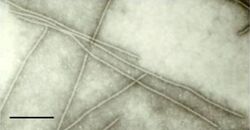Biology:Carlavirus
| Carlavirus | |
|---|---|

| |
| Virus classification | |
| (unranked): | Virus |
| Realm: | Riboviria |
| Kingdom: | Orthornavirae |
| Phylum: | Kitrinoviricota |
| Class: | Alsuviricetes |
| Order: | Tymovirales |
| Family: | Betaflexiviridae |
| Subfamily: | Quinvirinae |
| Genus: | Carlavirus |
| Species | |
|
See text | |
| Synonyms | |
|
Carnation latent virus group | |
Carlavirus, formerly known as the "Carnation latent virus group", is a genus of viruses in the order Tymovirales, in the family Betaflexiviridae. Plants serve as natural hosts. There are 53 species in this genus. Diseases associated with this genus include: mosaic and ringspot symptoms.[1][2]
Description
Carlavirus is described in the 9th report of the ICTV (2009).[3] The genus is characterised by having six ORFs (open reading frames) including a TGB (Triple Gene Block). The viruses are transmitted by insects.
Taxonomy
The genus was first proposed in the first report of the ICTV in 1971, as the 'Carnation latent virus group' but was renamed in 1975 as the 'Carlavirus group', and as the genus Carlavirus in 1995 (6th report). In 2005 (8th report) it was placed in the Flexiviridae family, having previously been unassigned.[4][5] The current position in the 9th report (2009) as a genus of the family Betaflexiviridae derives from the subsequent subdivision of Flexiviridae.[5]
The following species are assigned to the genus:[2]
- Aconitum latent virus
- American hop latent virus
- Atractylodes mottle virus
- Blueberry scorch virus
- Butterbur mosaic virus
- Cactus virus 2
- Caper latent virus
- Carnation latent virus
- Chrysanthemum virus B
- Cole latent virus
- Coleus vein necrosis virus
- Cowpea mild mottle virus
- Cucumber vein-clearing virus
- Daphne virus S
- Gaillardia latent virus
- Garlic common latent virus
- Helenium virus S
- Helleborus mosaic virus
- Helleborus net necrosis virus
- Hippeastrum latent virus
- Hop latent virus
- Hop mosaic virus
- Hydrangea chlorotic mottle virus
- Kalanchoe latent virus
- Ligustrum necrotic ringspot virus
- Ligustrum virus A
- Lily symptomless virus
- Melon yellowing-associated virus
- Mirabilis jalapa mottle virus
- Narcissus common latent virus
- Nerine latent virus
- Passiflora latent virus
- Pea streak virus
- Phlox virus B
- Phlox virus M
- Phlox virus S
- Poplar mosaic virus
- Potato latent virus
- Potato virus H
- Potato virus M
- Potato virus P
- Potato virus S
- Red clover vein mosaic virus
- Sambucus virus C
- Sambucus virus D
- Sambucus virus E
- Shallot latent virus
- Sint-Jan onion latent virus
- Strawberry pseudo mild yellow edge virus
- Sweet potato C6 virus
- Sweet potato chlorotic fleck virus
- Verbena latent virus
- Yam latent virus
Virology
The virions are non enveloped, filamentous, 610–700 nanometers (nm) and 12–15 nm in diameter.
The linear 5.8–9 kilobase genome is positive sense, single-stranded RNA. The 3’ terminus is polyadenylated. In some species the 5’ end is capped. The genome encodes 3 to 6 proteins including a coat protein located at the 3' end and an RNA-dependent RNA polymerase located at the 5' end of the genome.
Life cycle
Viral replication is cytoplasmic, and is lysogenic. Entry into the host cell is achieved by penetration into the host cell. Replication follows the positive stranded RNA virus replication model. Positive stranded RNA virus transcription is the method of transcription. The virus exits the host cell by tripartite non-tubule guided viral movement. Plants serve as the natural host.[1]
| Genus | Host details | Tissue tropism | Entry details | Release details | Replication site | Assembly site | Transmission |
|---|---|---|---|---|---|---|---|
| Carlavirus | Plants | None | Viral movement; mechanical inoculation | Viral movement | Cytoplasm | Cytoplasm | Mechanical: insects |
Transmission
Infection is at times spread by aphids in a semi-persistent mode, that is, the vector is infective for a number of hours.(Pimentel) Some species are transmitted by Bemisia tabaci in a semi-persistent mode or through the seed.[6] Most species infect only a few hosts and cause infections with few or no symptoms, for example, American hop latent virus and lily symptomless virus. Some, such as blueberry scorch virus and poplar mosaic virus, cause serious illnesses. (Foster)
References
- ↑ 1.0 1.1 "Viral Zone". ExPASy. http://viralzone.expasy.org/all_by_species/268.html. Retrieved 15 June 2015.
- ↑ 2.0 2.1 "Virus Taxonomy: 2020 Release". International Committee on Taxonomy of Viruses (ICTV). March 2021. https://ictv.global/taxonomy.
- ↑ King 2012.
- ↑ Adams, M. J.; Antoniw, J. F.; Bar-Joseph, M.; Brunt, A. A.; Candresse, T.; Foster, G. D.; Martelli, G. P.; Milne, R. G. et al. (2 May 2004). "Virology Division News: The new plant virus family Flexiviridae and assessment of molecular criteria for species demarcation". Archives of Virology 149 (5): 1045–60. doi:10.1007/s00705-004-0304-0. PMID 15098118.
- ↑ 5.0 5.1 ICTV: CTV Taxonomy history: Carlavirus
- ↑ Astier S. Principles of Plant Virology p78
Bibliography
- Martelli, Giovanni P.; Saldarelli, Pasquale (2012). "Carlavirus". in Tidona, Christian; Gholamreza, Darai. The Springer index of viruses (2 ed.). New York, NY: Springer. pp. 521–532. ISBN 978-0387959191. https://books.google.com/books?id=p-_hV6RiWocC&q=Narcissus%20common%20latent%20virus&pg=PA521. Retrieved 8 December 2014.
- Astier, S. Principles of Plant Virology
- Foster, Gary. "Carlavirus Isolation and RNA Extraction." Foster, Gary D. and Sally C. Taylorin. Plant Virology Protocols: From Virus Isolation to Transgenic Resistance. Page 145. 1998. Humana Press. Online. February 13, 2008.
- Pimentel, David. Encyclopedia of Pest Management.Page 407. CRC Press. 2002/ Google Books. Online February 13, 2008.. ISBN:0824706323
- King, Andrew M. Q., ed (2012). "Carlavirus". Virus taxonomy : classification and nomenclature of viruses : ninth report of the International Committee on Taxonomy of Viruses. London: Academic Press. p. 924. ISBN 978-0123846846. https://books.google.com/books?id=KXRCYay3pH4C&pg=PA924. Retrieved 9 December 2014.
External links
Wikidata ☰ Q2939048 entry
 |

